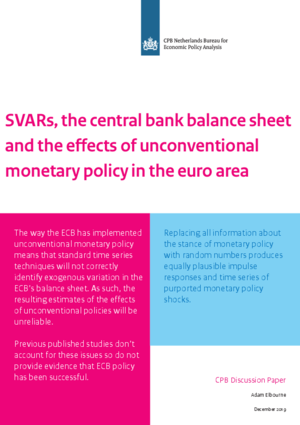SVARs, the central bank balance sheet and the effects of unconventional monetary policy in the euro area
VAR modeling shows the effects of unexpected exogenous variation in monetary policy, also known as policy shocks. This discussion paper presents a number of reasons why the existing literature is unable to isolate unexpected variation in monetary policy.
Downloads
First, almost all of the major unconventional monetary policies have been announced in advance. The consequence of this is that the observable movements in the balance sheet of the ECB are predictable, which leads to the well-known ‘foresight problem’ and, therefore, unreliable estimates. Secondly, the most important unconventional monetary policies up to 2015 have been implemented as "Fixed Rate Tenders with Full Allotment" (FRTFA). FRTFA policy means that the ECB offers as much liquidity to counterparties as they want if they have good quality collateral. Therefore, the amount of liquidity is determined by the demand of the counterparties, not by the supply of monetary policy. Third, many different policies have been implemented, which means that the parameters of the empirical models used are not constant throughout the sample. Fourth, there are relatively few observations in the period of unconventional monetary policy, which also leads to unreliable estimates.
This study replicates the most important estimates from the existing literature that investigates the empirical effects of unconventional monetary policy. In this study I show that the apparently exogenous variation on which these studies are based has no relation to what should be expected from these shocks. The estimated shocks in one of the most influential empirical studies even have the wrong sign in 11 of the 13 most important periods since unconventional monetary policy has been implemented.
Authors

